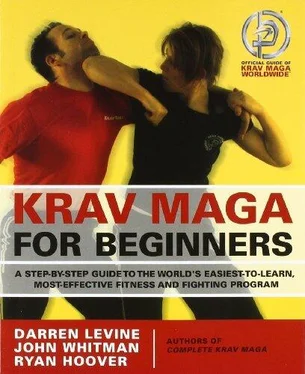Why is it so important to defend inward and forward? Why not just move the defense laterally across my face?
By moving your hand diagonally forward and inward, you can go out to meet the punch earlier in time and therefore farther from your face. If you move your hand laterally only, then you can only defend the punch as it arrives closer to you.
Training Tips:Practice slowly at first. Have a partner punch you slowly, but with a real punch that would touch you if you did not defend. Prove to yourself how small a defense you can make and still redirect the punch. Feel the punch slide along your palm. Once you feel comfortable with your ability to redirect the punch, have your partner increase the speed of the attack.
Have your partner punch you from a short distance away with a Straight Punch with Advance (page 74). If the attacker is too close to you, you may not have enough time to defend. In any case, in a real fight, if the attacker is that close, you should probably be attacking rather than trying to defend.
Inside Defense against Straight Punch Low
ATTACK→ The attacker throws a right straight punch to the defender’s midsection.
IMMEDIATE DANGER→ Being struck. The primary danger is being hit.
SECONDARY DANGERS→ Disorientation, balance. If the initial attack is not blocked, the defender may find himself disoriented by the first strike, or have the wind knocked out of him, or be knocked off balance, and therefore open to additional strikes.
SOLUTION→ Inside Defense (using the forearm or elbow)
1As the attack travels forward and down toward the body, use your left hand to redirect the punch (if he punches with his left, you defend with your right); keep your hand up so that you’re able to defend your face if the punch comes higher than expected. Lead with your elbow, but bring your entire forearm forward and cross your body, allowing the punch to slide along your forearm. You can get your forearm forward by extending from the shoulder and upper arm. At the same time, make a body defense by turning the defending shoulder and side forward to “blade” your body.

INITIAL COUNTERATTACK→ Straight Punch (page 71). During your initial training, practice the defenses only. Once you’ve learned the basic inside defenses, you can add a simultaneous straight punch with the other hand. The punch is generally made to the attacker’s face.
NEUTRALIZING THE ATTACKER→ After the initial counterstrike, the defender should continue to strike with elbows to the body and face. Students must focus on rendering the attacker unwilling or unable to continue the assault.
KEY POINTS
• redirect the punch by letting it slide along your forearm
• do not make the motion too big
• make sure your elbow travels forward as well as inward
• make a body defense by blading your body
COMMONLY ASKED QUESTIONS
I keep dropping my hand down when I defend. Is that OK?
No. Trying to drop your hand down will make a slower defense (since the hand is up and the punch is going down), and will leave your face open to additional punches.
I lead with my elbow, but the punch still comes very close to my body. What is wrong?
Most likely, you’re defending close to your body. Reach your defense forward by extending from the upper arm and shoulder (similar to the way in which a regular Inside Defense travels forward and inward).
Training Tips:When practicing with a partner, it’s very important for the attacker to make a strong fist to protect himself. If you defend early, your elbow or forearm may block the punch instead of redirecting it, and the attacker may crack his knuckles on the hard bones of your arm. This is unpleasant. Making a fist will protect the attacker’s hand from any real damage.
Note: It’s always slightly more difficult to make the body defense on your strong side (i.e., on your right side if you’re right-handed). Since that hip is back, it’s a bit harder to turn that hip forward to blade the body the other way. Be sure to turn your right hip and shoulder far enough forward to make the body defense. Fortunately, most attackers are right-handed, which means that if you must defend on this side, you’re usually defending against their weaker punch.
Remember, the body will always move more slowly than the arm—depend on the redirecting movement first, and use the body defense as insurance. Even though your body moves, let your arm and shoulder move first and be independent of your body; if you stiffen up too much, the entire technique will depend on the body movement, which will often be slower. Be sure to tighten your abdominal muscles as you defend so that you’ll be prepared to absorb the punch if it gets through. Also, contracting your abs shortens the length of your torso so that your defense (from elbow to fingers) covers more of your body.
As the name implies, Outside Defenses are made by moving the hand from an inside position outward, away from the center of the body. These defenses are made against straight punches that come from angles outside of our hands.
Defense against Straight Punch from an Outside Angle
ATTACK→ The attacker throws a right straight punch from the side, or from a diagonal position, or perhaps from the front if your hands are in the wrong position. Imagine having your hands up, but having an attacker standing at an angle to you. His straight punch will travel on a path outside one of your hands, rather than between them.
IMMEDIATE DANGER→ Being struck. The primary danger is being hit.
SECONDARY DANGERS→ Disorientation, balance. If the initial attack is not blocked, the defender may find himself disoriented by the first strike, or have the wind knocked out of him, or be knocked off balance, and therefore open to additional strikes.
SOLUTION→ Outside Defenses 1-5
As the attack travels forward, redirect the punch with an outward movement of the closest hand (your left). There are five variations of the Outside Defense. In ALL cases, try to defend at the attacker’s wrist or hand, rather than farther up the arm.
Note: For the sake of clarity, we’ll assume that ALL punches are straight punches coming from your left side—either in front of you but slightly to the side, or directly from the side, as described below. For an attacker standing on the other side, simply use the other hand. Each defense works both right and left punches (with a few comments, as noted below).
1An attacker stands slightly to your left and throws a right straight punch. Bring your forward hand up in a short arc. As your defense makes contact, rotate your wrist so that your thumb rolls toward the attacking hand. The motion of this arc MUST cross in front of your face since that’s where the punch is probably going. Redirect the punch away from you while making a small body defense with your head.
2An attacker stands slightly to your left and throws a straight punch. Bring your forward hand up in a short arc, with the back of your hand leading the motion. The motion of this arc MUST cross in front of your face since that’s where the punch is probably going. Redirect the punch away from you while making a small body defense with your head.
Читать дальше













